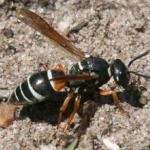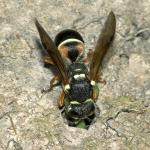Pseudopipona basalis SMITH 1857; Pseudopipona variegata misident.
The only representative of its genus in Britain, this species has always been regarded as a rarity, from its discovery in Britain in 1868 to the present day (Archer 2000). It is targeted for action under English Nature's Species Recovery Programme (Edwards & Roberts 1995; Roberts 1996, 1997, 1998, 1999; Roberts & Else 1997).
The species is restricted in Britain to a few heathland sites in the Poole Basin of south-east Dorset. This is a Holarctic species with records from western Europe (where it is rare), the Mediterranean region (including north Africa), and central Asia. In North America it is known from Alaska to New Mexico.
Listed as Vulnerable (RDB2) in Shirt (1987), and provisionally upgraded to Endangered (pRDB1) by Falk (1991). If the new nesting localities occupied in 1997 become firmly established, the status may need revision. Despite the extreme restriction of its British range, it can be abundant when local conditions allow.
Entirely on heathland. The species has complex requirements, needing exposed ground with a clay content (as a nesting site), open water (to assist in nest building) and heathland rich in bell heather (for both nectar and prey foraging).
Univoltine; mid June to early August, occasionally into mid August. There may be a small partial second brood in favourable seasons.
The nest cells are provisioned with paralysed larvae of the moth Acleris hyemana (Lepidoptera: Tortricidae). No other prey species has been recorded in Britain.
The species nests in dense aggregations; the nest burrows being excavated in bare ground in sunny situations. The burrows are shallow (only a few centimetres deep), and may contain up to three cells (Spooner, 1934). The cells are stocked with 12 to 20 moth larvae. The completed nest burrow is sealed with a plug of moistened clay (pers. obs.).
Apparently restricted to bell heather. As both sexes of the species have short tongues, the flowers are invariably raided by biting through the base of the corolla.
None reported, although females of the bombyliid fly Bombylius minor have been observed ovipositing in the vicinity of P. herrichii nest burrows (pers. obs.).
2001




